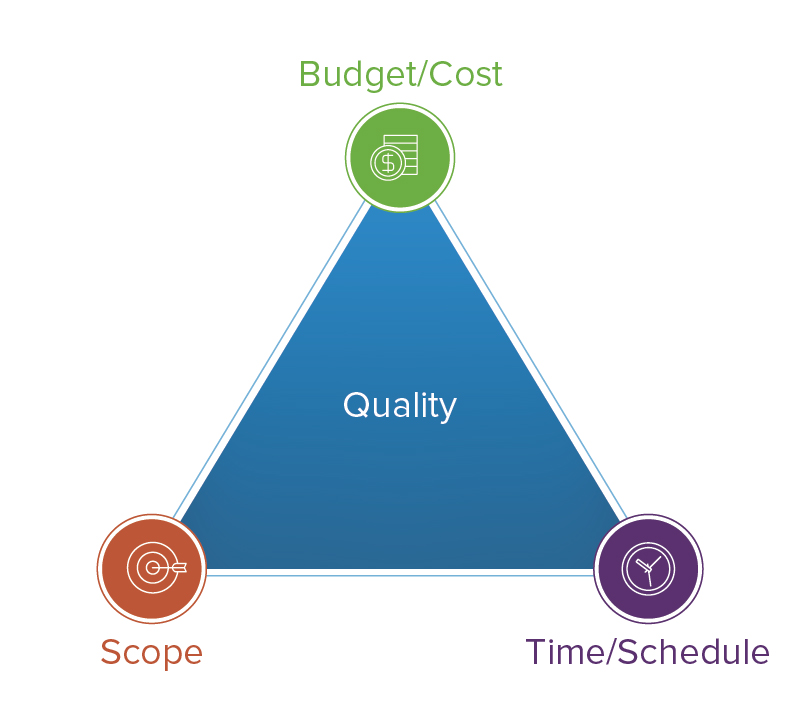By: Christina Olivarria, BS, LBBP
When planning the project schedule, a project manager should begin by asking themselves the following questions:
- Where are we?
- Where are we heading?
- What adjustments need to be made to get us there?
Project schedule management is linked intrinsically to the Project Management Triangle and is a key determinant, alongside scope and cost management, of whether a project is deemed successful. Despite all the project-based software available to today’s project managers, human management is still required, especially when managing large, complex projects. Thus, a project manager’s ability to understand the key components required to properly plan the schedule is essential to a project’s success. These components include the development of the work breakdown structure, defining of project activities, creating a logical method of linking these activities, defining resources, and continuous evaluation of the schedule. By ensuring that these components are considered, the schedule will facilitate a more accurate estimating, resource allocation, and risk analysis process.

The most crucial part of schedule management is the creation of a solid work breakdown structure. The work breakdown structure essentially divides the project into bite-size manageable pieces. At Yellow Brick, we create deliverable-based work breakdown structures to help us manage the complexity of opening a new hospital facility. The work breakdown structure defines the what of a project, helping the project manager organize the scope of work. By following the 100% rule, the work breakdown structure should include the whole of the work to be completed, no more and no less. Any work that is requested that is not listed in the work breakdown structure is considered outside the scope of the project. The lowest level of a work breakdown structure is a work package. A work package for an organization is typically stated in a verb-noun structure, like “Develop Parking Plan” or “Validate the number of FTE’s required” and is assigned to one task coordinator. Development of a complete and sound work breakdown structure assists in the development of a clear project vision.
Defining project activities further elaborates on the work packages defined in the work breakdown structure. This results in subtasks that are both traceable and measurable for a project manager. When creating these activities in a project schedule, a project manager should design the schedule with a logic that links tasks throughout the project. A properly planned schedule will have every activity, except the first and last, linked to at least one predecessor and one successor task. Most of the activity schedules that our organization creates follow a Finish-Start with soft logic, which creates links with requirements based on our past knowledge and historical data about projects.
Once the work breakdown and the logic are defined, the last step is defining the resources required. This often is done by socializing the tasks to our project committee members and requesting the team to validate who should be responsible for the management of the activity. Our team also ensures that the resource defines the proper duration for the activity. Consulting the resources themselves is incredibly valuable, as they understand the environmental factors specific to their hospital system, that we as consultants may not have knowledge of.

A great project manager understands that although a schedule may be complete, a key last step is an evaluation of whether the project schedule is achievable. This involves ensuring that all items listed in the scope and contract are included in the project schedule. A simple validation technique is checking the contract deliverables line by line. Although tedious, this ensures all aspects of the statement of work are captured in the schedule. Another technique is the analyzation of the critical path, which is the longest path of a project. When looking at the critical path, a project manager should ensure that all milestones listed on the critical path make logical sense. We utilize the Microsoft PowerPoint Timeline tool to input the milestones and highest levels of the work breakdown structure to create a streamlined schedule visual. Using this tool, we are able to identify opportunities to add lag time to phases, leaving our team cushion in the event of a construction schedule slip.
The project manager should consistently evaluate the project schedule throughout the life of a project. The core project team must have a firm understanding of the schedule’s critical path to fully comprehend the eventual goals of the project. If properly planned and developed, a project schedule can be used by the entire project team to assist in planning the overall costs and potential risks and can serve as a roadmap to ensure that all work required is completed.
References:
Jones, E. F. (2009). Scheduling 101—the basic of best practices. Paper presented at PMI® Global Congress 2009—North America, Orlando, FL. Newtown Square, PA: Project Management Institute.
Averous, J., Linares, T., & Project Value Delivery (2015). Advanced scheduling handbook for project managers. Singapore: Fourth Revolution Publishing. ISBN-13: 9789810943226 (print); 9789810943233 (eText)
Project Management Institute, Inc. [PMI]. (2006). Practice standard for work breakdown structures (2nd ed.). Newtown Square, PA: Project Management Institute. ISBN-13: 9781933890135
Project Management Institute, Inc. [PMI]. (2011). Practice standard for project estimating. Newtown Square, PA: Project Management Institute. ISBN-13: 9781935589129
Project Management Institute, Inc. [PMI]. (2017). A guide to the project management body of knowledge (PMBOK Guide) (6th ed.). Newtown Square, PA: Project Management Institute. ISBN-13: 9781628251845

